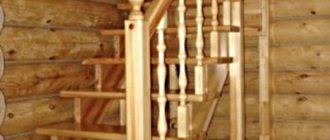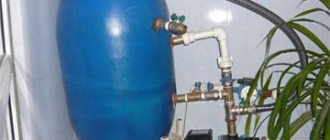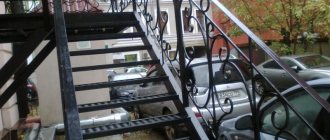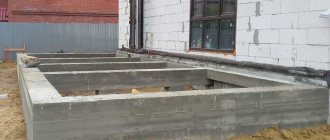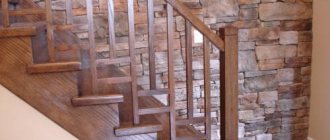A staircase is a complex building structure that must be highly reliable, safe, durable, aesthetically pleasing and comfortable. A concrete staircase meets all of the above standards. It is better to entrust the manufacture of concrete stairs to professionals. When carrying out work, you need to make the correct calculations, create a unique project and follow all the steps of the step-by-step instructions.
Such a staircase is often installed in permanent or street buildings made of concrete and brick; its service life is more than 50 years, and subsequent cosmetic repairs will update the design and extend its service life to 100 years.
Advantages of concrete stairs
In comparison with a wooden structure, the laying of a concrete staircase is carried out during the construction of a private house. This is one of the details of the object that enhances the structural strength. Other advantages of the structure include:
- reliability, strength, long service life;
- moisture resistance, minimal risk of fire;
- the possibility of laying together with the building, which ensures savings;
- use of corrosion-resistant steel reinforcement;
- possibility of finishing with any building material;
- resistance to negative external factors and increased use.
Finishing
Wood creates coziness and a homely atmosphere
An equally important process is the finishing of the concrete staircase. It will affect the durability and appearance of the structure, as well as the interior of the living space. It will give it elegance and solidity.
Wood is often used to decorate concrete stairs. It has the following qualities:
- good thermal insulation properties
- safe movement
- no special care required
- harmony with any room interior
- creating a comfortable, homely environment
It also does not place a large load on the base of the structure, which is important for heavy concrete structures. It is used for finishing all shapes and types of stairs. Balustrades and railings are also often made of wood. Decoration in the form of artistic cutting is possible.
Carpet – soft in structure and silent when walking
For families with small children and elderly people, carpeting is suitable. It is soft in structure and creates noiselessness when walking. It spreads without cuts and is fixed with strips of wood or plastic. A layer of felt under the carpet, or similar material, will extend its use.
Having a harmonious combination with any finishing materials, concrete can be decorated in several ways, for example, combining wooden and chrome elements.
Tile is a good finishing option
Clinker steps and tiles are another lining material. It is not difficult to lay clinker steps, which are produced in prepared form and they can fit in size. If the dimensions do not match the structure, screed with a cement mixture is carried out. When tiling, it is also used for approaches.
Ceramic tiles are not recommended for finishing spiral staircases, because... it will have to be trimmed. Due to numerous seams, the appearance of the structure will deteriorate. It is more suitable for straight marches. The laying starts from the bottom.
Illumination adds originality to the look
Neon and LED lighting, as well as plastic and glass decor, give the structure a unique, original look.
Working with natural stone is similar to working with tile finishing. The material has disadvantages:
- expensive
- noisy when walking
- discomfort from the cold material
- difficult to care for
Natural stone, marble, granite have a big advantage. These are durable materials.
Before painting, the surface is thoroughly cleaned
Painting concrete steps is cheap. The wear time will increase, but painting will not be able to protect against the cold of concrete and noise when walking.
Choosing the type of staircase
Before starting construction work, you should decide on the type of structure, the shape of the staircase, and select suitable high-quality building materials. You should not save much on purchasing raw materials, as its quality can greatly affect the reliability and durability of the finished product. The staircase cannot be used immediately after pouring the steps, since the concrete will take up to 4 weeks to gain strength . Only after this can the formwork be removed. You also need to decide in advance on the location of the structure and the method of opening the doors.
By design, monolithic staircases are divided into straight (one- and two-flight), spiral (or screw). Screw options with winder steps have an aesthetic appearance; they are more in demand among consumers, but require formwork with a radial shape, so they are most often made to order.
An elementary option is a straight interfloor staircase with one flight, located between two walls. In this case, there will be no end parts of the structure, and the formwork is fastened to the walls. It is more difficult to make a semicircular or monolithic structure resting on one wall. To design the free end, you need to add one side part to the structure. You can choose a marching system where there are no supports on the walls (the lower and upper floors serve as load-bearing elements); the formwork is assembled with side elements.
But there is not always enough space to build a single-flight version, so preference is given to a two-flight version with winder steps or platforms between the flights.
Concrete stairs can also be monolithic, combined, prefabricated from factory-made flights, or type-set.
The first type is performed on site using the technology of pouring concrete mortar into the formwork, and can be installed anywhere (on the porch, street or basement).
The classic version of a completely monolithic design
The second option is a metal structure of complex shape (frame) with concrete steps. Each step is cast using formwork and reinforcing mesh, and marble chips and granite crushed stone are used as building materials. The dried surface is polished.
Combined version with metal frame elements
Prefabricated prefabricated flights are used mainly in apartment buildings, however, if desired and a small crane is available, this option can also take place. The main advantage is the price, the disadvantage is the limitation of standard sizes.
Serial marches of factory production
Stacked types consist of a concrete beam (stringer) and individual steps, which are rectangular, triangular, corner and with a groove. Reinforced concrete types are made in a factory according to specified dimensions and have a standard shape.
Staircases on steel stringers
Basic rules, the implementation of which will strengthen the monolithic staircase landing
When designing, the most important thing is the accurate calculation of loads. The load impact point is below the central part of the flight. The main load is experienced by the steps of the stairs, but tensile loads have the greatest impact on the span and the supporting platform. Concrete can withstand a certain level of loads up to a certain point, after which cracking occurs in the place experiencing a tensile load, and the destruction of the entire structure.
Reinforcement frame for concrete stairs Source drive2.ru
Calculation of stairs
Before starting construction work, you need to measure the space, make a diagram, drawing or project of the planned structure with a preliminary calculation of all elements and indicating the required dimensions. The drawing is developed reflecting design parameters, number of steps, height and width. As a rule, the height of the steps is 15-18 cm, and the minimum span width is 80-90 cm. You also need to take into account the thickness of the finishing material, know the building codes, carry out the work in stages, and do not forget about the presence of fences and embedded elements.
Climbing angle
The first parameter is the angle of inclination (lift), the value of which affects the length and height of the structure. So, with the same height, a product with a tilt angle of 25° will be longer than analogues with indicators of 35° and 45°. The construction of a staircase structure with an angle of 45 degrees (span projection 3 meters) will require 2.35 times less building materials than for a product with an angle of 25° (span projection 6.4 m).
Optimal slope range 24 - 37 degrees
According to the manual, you need to choose the elevation angle based on the appropriate size of the flight, the complexity of the structure and its comfort.
Step sizes
Having decided on the angle of inclination and height, the work of designing concrete stairs includes breaking them down into steps. The optimal step size for calculation is 27-30 cm in width and 16-20 cm in height. If you make higher steps, it will be more difficult for both the elderly and people who are accustomed to a standard step to move along them. Very low steps of less than 15 cm will also be uncomfortable for an adult, but for children this is the best option.
You can select the parameters of the steps using the formula: 2H+L = 60-64 cm, where H is the riser (step height), L is the tread (width). To calculate, you can take the above indicators: 2*18+30=66 cm.
Counting the number of steps and span
Stair width
As a rule, the width of a staircase in a country house depends on the free space or space between the walls where it will be placed. It should not be narrower than 80 cm, since when climbing to the second floor along a narrow staircase (or descending from it), a person will feel like in a tunnel. It will also be inconvenient to carry any objects. Therefore, the optimal size would be 90-120 cm.
It is imperative to build a safe and secure fence, especially when elderly people and children live in the house. If the fence is located on the steps, it will slightly reduce the effective width of the flight, keep this in mind when calculating.
Online calculator for calculation
For your convenience, you can make all the calculations using a convenient online staircase calculator.
Technical characteristics (width dimensions, turning radius, GOST)
Any type must comply with government standards and safety requirements. Main technical characteristics of the staircase structure:
- the widest part of the degree does not exceed 40 cm, the narrowest - 10 cm;
- step height – 12-22 cm;
- between turns, all winder steps are the same size;
- on straight flights the steps are also the same width;
- edge of the tread - no more than 4 cm;
- rotation is provided by 7-9 winder steps;
- do not take winding steps - they are inconvenient and increase the risk of falling;
- minimum radius of curvature – 30 cm;
- between the flight and the interfloor ceiling no more than 2 m.
Leave the distance between the flights of a U-shaped staircase more than one quarter of the width of the steps. This way you will maintain the normal depth of the winder step - more than 10 cm, which meets GOST, the safety of the stairs and is much more convenient to use.
Winder steps sometimes begin or end a staircase. What are the consequences of violating requirements? At best, the steps will not last long. At worst, there will be a collapse.
Formwork assembly
After completing the calculations, you need to build the formwork yourself. For construction you will need the following materials:
- moisture-resistant plywood 1.2-1.8 cm thick, edged boards 3 cm thick for the bottom of the formwork, edging and risers;
- sheets of moisture-resistant plywood (0.6-0.9 cm each) for the manufacture of curved zones;
- support beams 10x10 cm or boards 15-17 cm wide and 5 cm thick for supports;
- beams 10x10 cm for mounting boards or plywood sheets;
- metal corners;
- fastenings (wood screws) 3.5 mm;
- concrete, trowel for leveling mortar, trowel, device for smoothing the edges of concrete structures.
To ensure that the concrete surface remains smooth after hardening, it is necessary to grind the wooden formwork parts in contact with the mortar. When using smooth plywood, no leveling procedures are required.
1 - timber for fastening formwork elements; 2 - tension beam; 3 - winder stage formwork; 4 - end formwork.
The formwork must be assembled using the following steps:
- The lower part is made of large boards and plywood sheets. They are tightly fastened together with bars from the outside. The bottom of the structure is supported by beams or boards, and the pitch of the supports must correspond to the pitch of the steps. The parts are secured with self-tapping screws, which are convenient to unscrew during dismantling;
- On the sides they place a flange made of edged boards or plywood, reinforcing it from the outside with boards;
- install riser bars to the flange or wall with metal corners;
- joints in parts are sealed with a mortar of cement and sand or leveled with a plane or grinding machine.
Layout of formwork elements
The thicker the beams, the higher the structural strength. The weight of a reinforced concrete structure will be large, which must be taken into account during the construction process. You can add additional rigidity using transverse bars.
Kinds
The following concrete staircase structures are distinguished:
- monolithic
Monolithic
The solution is poured into a mold that must be prepared in advance. The design is cast. Installed directly at the point of use. The model is selected based on the area and design of the room.
- marching
Marching
The march structure occupies a large area of the room. Consists of 1 or many marches that connect levels, and has the following advantages:
- simple design
- installation does not require much time
- beautiful appearance
- comfort, safety of descent and ascent
- low cost
- screw
Screw
A convenient, compact design is an alternative to the marching design. Saves space. It looks very rich with metal railings in addition to glass elements.
- combined
Combined
A complex metal structure (frame) on which concrete steps are fixed.
Stairs can be supported on walls on one side or both, or simply hanging with fastening to the floor and ceiling on top. If calculated correctly, the structure will be equally strong. Connecting to a wall does not in any way increase the load-bearing capacity of the march. They do this largely to save space or make it easier to install the formwork.
It is better not to undertake the construction of complex forms yourself, but to entrust the work to professional craftsmen. Without relevant experience, it is unlikely that anything will work out.
Reinforcement
For a small staircase in a cottage, the reinforcement can be made with a mesh, which is tied from reinforcement measuring 1-1.2 cm at a distance of 15-20 cm (the size of the mesh cells will be 15x20 cm). The rods are connected with wire.
March reinforcement scheme
Large products must be made from a reinforcement frame, including several meshes mounted with vertical rods or welding. The distance between the grids is 2-3 cm.
The frame is the skeleton of the structure where the hardened concrete solution will be fixed, so its horizontal rods must be fixed in the wall, in pre-drilled holes . The mesh or frame is laid in the lower area of the formwork 2-3 centimeters from the bottom (the reinforcement can be raised using stands, bricks or stones). In the area where the railings are located, you need to place plugs or metal plates.
Video description
How to make a concrete staircase, watch the video:
- assemble the formwork using self-tapping screws, special ties, and metal corners;
- formwork parts are adjusted as accurately as possible, without joints or cracks; otherwise, as a result of moisture leakage from concrete, its strength will significantly decrease;
- It is advisable to additionally seal the joints with polyurethane foam; you can lay the formwork from the inside with a durable thick film;
- If necessary, embedded parts are provided for fastening racks or balusters.
The formwork is assembled in such a way that it is as airtight as possible Source dekormyhome.ru
Pouring concrete
During concreting, a grade of concrete not lower than M200 (from class B15) is used. The solution is mixed in a concrete mixer or ordered from RBU and must contain the following components: 10 parts of cement, 30 parts of crushed stone fraction 10-20 mm, 20 parts of sand and 7 parts of water. If the composition is dense, you can add 3 parts of water.
Now you need to fill the composition correctly:
- the lower steps are performed first;
- the solution is compacted to give strength and density. To do this, you can use reinforcement, which is used to pierce the concrete in several areas. professionals recommend using a more reliable method - a construction vibrator, which squeezes concrete through the formwork;
- giving the steps the correct shape, smoothing them with a trowel;
- pouring the remaining elements and the porch;
- covering the solution with a film to protect it from cracks and early hardening. You can also regularly moisten the outer surface of the flooded area with water.
Video description
The step-by-step process of assembling formwork and installing reinforcement is shown in this video:
How to install fittings
Before pouring a staircase located along the wall, it should be further strengthened using reinforcement walled into the wall.
What is required for this:
- in porous materials, for example, in aerated concrete, pits are made into which concrete is poured, and only then steel pins are inserted into them;
- for double-flight structures, in order to strengthen the adhesion between materials, grooves are knocked out in which metal corners are mounted.
The reinforcement is fixed in the wall Source sevparitet.ru
Finish lining
A DIY concrete staircase can have different finishing options: wood, laminate, tiles, carpet, acrylic stone or porcelain stoneware. Any material must be laid on a level base. After dismantling the formwork, uneven areas may remain on the site, which are recommended to be removed by sanding and plastering. The end parts are usually finished with plaster and painted. After this, the steps are covered with one of the materials.
The surface can be covered with tiles, artificial or natural stone with a rough surface. The material is laid on cement mortar or tile adhesive. Using the same technology, mosaics are laid, creating original compositions from small elements.
Photo instructions for installing clinker steps
The finishing can be done with wood panels that are resistant to abrasion. For this purpose, larch and exotic species that have undergone antiseptic treatment are selected.
Installation of larch wood cladding
An excellent treatment option is laminate, which is abrasion-resistant, easy to install and durable.
Installation of special stair laminate
If children or elderly people live in the house, then you can choose carpet, available in different colors.
The final stage is finishing with carpet
To save money, you can simply paint the steps with high-quality concrete paint.
Painting is a cheap but interesting option
In any case, the appearance of the staircase is associated with the taste preferences and financial capabilities of the owner.
Construction stages
In general, the work on constructing a concrete staircase consists of the following main stages:
- Determination of the type of staircase: single-flight, two-flight, spiral.
- Design calculation: number and dimensions of steps, width and length of the structure.
- Production and assembly of formwork.
- Installation of reinforcing belt.
- Pouring concrete.
- Dismantling of formwork.
- Finishing concrete stairs with wood, artistic forging, ceramic tiles, mosaics or other available materials.
A two-flight and spiral staircase made of concrete is a rather difficult project to implement with your own hands. The flights of two flights of stairs are erected at an angle of 90 degrees, with an intermediate platform, winder steps and other features.
A spiral staircase requires a complex special calculation of the spiral line and the subsequent manufacture and correct installation of curved formwork. Therefore, it is better to trust the construction of these types of stairs to experienced professional builders. Within the framework of this article, an option will be considered - a single-flight concrete staircase to the second floor, which you can make with your own hands without experience or special education.



